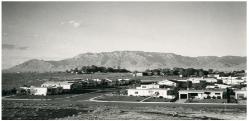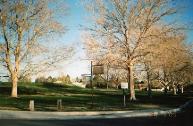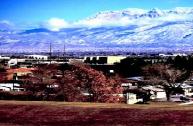Neighborhood History
The Netherwood Park neighborhood has a history going back to the 1890’s when Albuquerque had only 4,000 residents, four public schools, and a state university with only seven staff members. Today, your house or apartment is located on the land that three teachers purchased as an investment that they hoped would provide a measure of financial security.
 Ada Cutler was born in Illinois in 1859. She comes to Albuquerque in about 1891 to teach in the new public school system. She took what little savings she had and walked in the Bernalillo County Courthouse on Jan. 14 1896 and purchased 160 acres for just $1.25 an acre. She convinced her friends, Martha Taylor and Alcinda Morrow who taught at the University of New Mexico to join her by buying land adjacent to hers.
Ada Cutler was born in Illinois in 1859. She comes to Albuquerque in about 1891 to teach in the new public school system. She took what little savings she had and walked in the Bernalillo County Courthouse on Jan. 14 1896 and purchased 160 acres for just $1.25 an acre. She convinced her friends, Martha Taylor and Alcinda Morrow who taught at the University of New Mexico to join her by buying land adjacent to hers.
Alcinda Morrow and Martha Taylor were there to greet students when the University of New Mexico first opened in the fall of 1892. Ms. Morrow was born in Indiana in 1843 and taught at the University of Kansas from 1877 to 1880, followed by teaching assignments in Minnesota and Argentina. She was professor of Education and Spanish at UNM. She purchases land in what is now our neighborhood on May 21, 1896. She resigns from UNM, gets married that July, and moves with her husband to Los Angeles.
Martha Taylor loved the outdoors as much as she loved to teach. She was born in Ohio in 1861 and graduated from Oberlin College in 1887. She came to Albuquerque in 1892 to accept the position of Chair of English Literature and History at the University of New Mexico. She also taught geography and led her students on field trips to the Sandias. One of her students, Charlotte Ellis, became the noted local botanist who drew up the first systemic classification of the plants of the Sandias. Ms. Taylor bought her land on February 1, 1896. Why would three well-educated women purchase land in the middle of nowhere? They lived through the Panic of 1893 which closed two local banks and sent the economy reeling so they did not trust banks. Albuquerque was growing and it was anybody’s guess as to where it would grow next. The teachers were investors saving for the future.
Did the three teachers build a house for themselves with a window view of their adjacent land tracts? This house is more legend than fact. In 1891, M. P. Stamm, a local fruit wholesaler, starts the Terrace Addition Improvement Company with several other business leaders. Each pledges to build a house in the area. Stamm names the streets after trees-Cedar, Elm, and Oak (near Presbyterian Hospital today) and starts to build his house. He digs a well for water and nearby farmers protest and throw rocks at him. His other backers abandon the project and Stamm puts off his plans for several years until the water problem can be solved. Our three teachers dreamt of a house but probably faced the same problem.
By 1899 all of them left Albuquerque- Alicia Morrow for California, Martha Taylor for Arizona, and Ada Cutler for Denver-while still holding the rights to their land. Alicia sells her land to Ada in 1905 and dies five years later. She is credited as being the founder of the English Department at UNM. Martha resigned from UNM in 1899 and is credited as the founder of the UNM history department. She then married and moved to a ranch near Somerton , Arizona. She would sell her Albuquerque land in 1910 and it would in time be sold in turn to Ada Cutler. Martha Taylor died in Arizona in 1947. Only Ada Cutler would eventually return to Albuquerque after she married Edwin Netherwood.
, Arizona. She would sell her Albuquerque land in 1910 and it would in time be sold in turn to Ada Cutler. Martha Taylor died in Arizona in 1947. Only Ada Cutler would eventually return to Albuquerque after she married Edwin Netherwood.
Edwin Netherwood was born near Albany, New York, in January, 1845. His family moved to Wisconsin and he served in Company 50 of the Wisconsin Infantry in 1864 during the Civil War. He married Abbey Clark in 1873 and moved to Holyoke, Massachusetts. They had two daughters, Marietta and Emma. Mr. Netherwood worked as a carpenter and home builder. By the 1890’s he had a small real estate business. The unexpected death of Emma in 1894 may have lead to the breakup of his marriage in 1899. He set out for Cripple Creek, Colorado and then went on to Denver where one of his sisters was a schoolteacher. He worked in a real estate company in the Park Hill Section of Denver. There is no record of how he met Ada Cutler, who was teaching at Whittier Elementary School. They were married on November 9, 1900 in Denver. They moved to Albuquerque from Denver in on October 8, 1908. The 1910 Census showed that they lived in the Los Duranes neighborhood north of Old Town and that Mr. Netherwood listed his occupation as carpenter and worked briefly for M. P. Stamm who was building homes at this time.
The Netherwoods would have noticed that Albuquerque’s growth was pushing eastward towards the UNM area. The Albuquerque Country Club moved to a site just north of UNM in 1907 (the present location of the Aquinas Newman Center). The first home in the area, the Warner-Gilchrist house was built in 1908 at the corner of Cornell and Silver (and torn down in 2011). The Netherwoods owned several hundred acres north of UNM while the premier real estate developer of this time, Colonel D. K.B. Sellers was putting his mark on the land south of UNM. Colonel Sellers insisted that the city government change the name of Railroad Avenue to Central Avenue. He drew up the land plat map for the neighborhoods south and east of UNM and named all the streets from Yale to Carlisle after famous universities. He was the man in the fedora standing next to a large sign that reads ”NOB HILL” in the ionic 1937 historic photo. This larger-than-life businessman and politician influenced the work of every real estate developer from 1906 to 1947 this time including the Netherwoods.
Albuquerque had about 15,000 residents at the dawn of the roaring 1920s. Both Netherwood Park and the UNM neighborhoods were outside the city limits. Ada and Edwin Netherwood lived in Netherwood Park and their estate included a three-room guesthouse, a garage, their residence, a water well and a tower. What they lacked were neighbors.
Their friendly real estate rival, D.K. B. Sellers, had better success in his attempts to develop the land south of the university. Sellers owned land adjacent to Central that connected travelers to two key destinations: UNM and downtown. He controlled a major water well. He also had the political clout to convince Mayor Clyde Tingley to have the City annex his new neighborhoods south of UNM in 1926. The Netherwoods had none of these advantages and two major disadvantages: their land was subject to heavy summer flooding and Mr. Netherwood was now past 80 years old and in failing health. He died on November 26, 1926.
Ada Netherwood now faced many difficulties without him. She moved into the guesthouse and rented the residence to John Combs and his family. The Coombs family looked after her until she died in August, 1937. She was buried next to her husband in Fairview Cemetery on Yale S. E. Her only heir was her nephew, Edward Schell. The years from 1938 to 1949 featured two mileposts in the history of our neighborhood. The Bernalillo County Commissioners met on April 23, 1940 and changed all the street names. The next day streets were named after colleges and universities to extend the pattern first established many years before by D. K.B. Sellers. East 21st Street becomes Girard Avenue to honor a leading Albuquerque merchant in the 1880's. East 30th Street became Carlisle Boulevard. There is no record of how many people were confused by all these changes and how many new road maps were sold. The University of New Mexico Golf Course (now known as the North Course) opened in 1942 as a championship course with eighteen tough holes. The course hosted 1948 Albuquerque Open won by 1947 Masters' champion Jimmy Demaret.
 Sometime in late 1949 Edward Schell, dean of the Wheaton College Academy in Wheaton, Illinois received a letter telling him that his land in Netherwood Park would soon be annexed. This annexation was passed by the City Council on January 24, 1950, and added 3300 acres of what we know today as the mid-northeast heights under the rule of the city government. The Albuquerque Journal reported on its front page the next day that there were only 15-20 residences in this vast area. Mr. Schell retired from Wheaton and moved to Albuquerque that summer. Mr. Schell was the nephew and only heir of Ada Cutler Netherwood and a man used to getting things done his way. He drew up a restrictive covenant that proclaims that “no lot or part of a lot in Netherwood Park…(can be used) for the sale of intoxicating liquor, a slaughter house, junk yard, night club, skating rink, pool hall, or drive-in theatre”. He insisted that the other five property owners in Netherwood Park sign this document.
Sometime in late 1949 Edward Schell, dean of the Wheaton College Academy in Wheaton, Illinois received a letter telling him that his land in Netherwood Park would soon be annexed. This annexation was passed by the City Council on January 24, 1950, and added 3300 acres of what we know today as the mid-northeast heights under the rule of the city government. The Albuquerque Journal reported on its front page the next day that there were only 15-20 residences in this vast area. Mr. Schell retired from Wheaton and moved to Albuquerque that summer. Mr. Schell was the nephew and only heir of Ada Cutler Netherwood and a man used to getting things done his way. He drew up a restrictive covenant that proclaims that “no lot or part of a lot in Netherwood Park…(can be used) for the sale of intoxicating liquor, a slaughter house, junk yard, night club, skating rink, pool hall, or drive-in theatre”. He insisted that the other five property owners in Netherwood Park sign this document.
The rapid growth of Albuquerque in the 1950’s was beyond the limited resources of city government. Edward Schell offered to pay for the paving of Princeton Avenue if the City would pay him back at a later date. The City accepted land at the corner of Morrow and Princeton for a city park in 1951 but left the land sitting idle. The City turned down an offer in 1956 to sell the park to developers for the proposed Albuquerque Tennis Club. The City estimated the cost to landscape the park at $40,000 in 1962. A group of forty neighbors met with the City in August, 1962. They agreed to make regular donations to a fund for the park. The City Parks Board hailed this effort and revised its cost estimate to $20,000. The final plan was approved that October. Netherwood neighbors donated over $2,000 in cash and services and the landscaping project began several months later.
This history project is an ongoing effort. Do you have stories and pictures of our neighborhood’s early growth that you would like to share? Please contact NPNA member John Vittal. Thank you.
